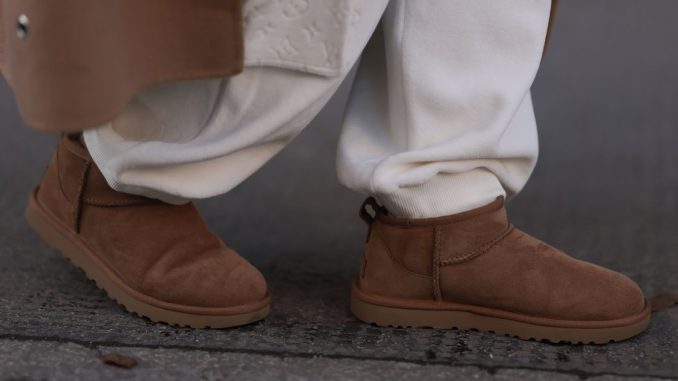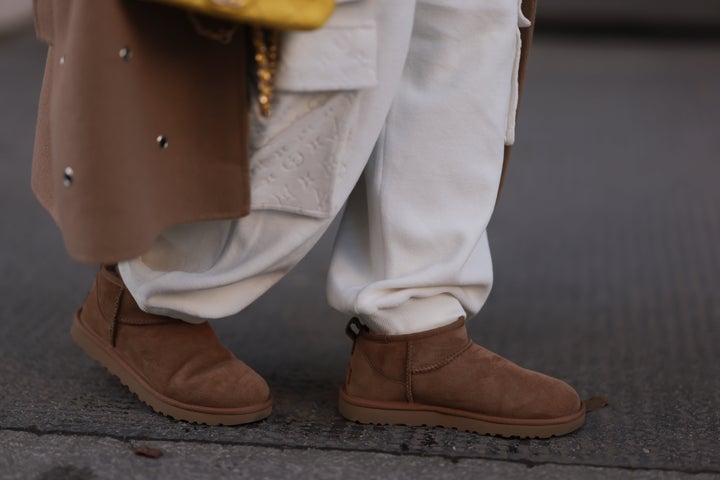
Having graced the fashion week runways in Paris and London, as well as the feet of celebrities like Gigi Hadid, Kendall Jenner and Keke Palmer, it’s safe to say that Uggs are officially back in style.
Although the aesthetic merit of this 2000s fashion staple has been hotly debated, what’s not up for debate is the undeniable warmth and comfort of the Ugg.
Edward Berthelot via Getty Images
However, it’s the very same features that endear customers to Ugg’s classic boot from the 2000s (as well as similar knockoffs from other shoe manufacturers) — their flat, flexible soles, looser fit and plush sheepskin lining — that also make foot experts like podiatrists and orthopedists cringe. We spoke to several such experts to find out why they don’t recommend we wear this style of boot.
Foot doctors warn against wearing this style of boot — here’s why.
High heels and other types of overly cramped footwear are well-known culprits of painful foot issues. However, shoes that are too loose can also make wearers susceptible to various issues.
“Too much motion can lead to overuse syndromes, such as tendonitis,” said Dr. Frances J. Lagana, a Massachusetts-based podiatrist and division chief of podiatry at UMass Memorial Health. “It can also create shearing injuries resulting in blisters and calluses.”
The extra space inside the shoe may cause your foot to work harder than it needs to, which may lead to overuse injuries such as sprains and plantar fasciitis.
“[These boots are] very roomy, so they can cause overuse of the musculature and the tendons of the feet. Essentially, when you’re wearing a shoe that isn’t secure, you’re trying to hold a shoe on with your foot as you walk,” Lagana said.
It may seem logical to avoid these problems by going down a shoe size. However, according to Lagana, going down a size won’t fix the problems caused by an unstable shoe.
“[These boots] are not mechanically stabilizing. They’re not secure in the sense that a laced boot or shoe would be,” she said.
And the more we wear our boots, the worse this issue of roominess can become.
“Over time, the fleece fibers of this type of shoe can compress down and the fabric can expand, which can cause your foot to slip and slide even more in the shoe,” said Dr. Meghan Kelly, a New York-based, board-certified orthopedic surgeon and assistant professor of foot and ankle surgery at Mount Sinai.
There’s also a major lack of support.
While Ugg has released many different styles over the years, including recent styles with thicker platform soles, the iconic boot of the mid-2000s sported a thinner, more flexible sole — perhaps too flexible.
“If you can fold a shoe in half, like with ballet flats, it’s not going to give you enough support,” Kelly said.
Podiatrists and orthopedists also warn that the lack of arch support in many styles of Uggs and Ugg-type shoes can cause painful foot issues like plantar fasciitis and tendonitis.
“I wouldn’t say [Uggs] are any more dangerous than any other pair of unsupportive shoewear,” Kelly said. “You’d see similar problems in patients who wear other unsupportive shoes all the time, like flip-flops or any other kind of sandal without arch support.”
While a simple arch support insert may seem like the obvious solution, unfortunately, this could potentially cause even more issues.
“Orthotics or shoe inserts can only be as effective as the shoe they are put into,” Lagana said. “The foot might become more painful with an orthotic in this type of shoe because it will have the ability to move around, which can potentially irritate the foot or make it sore.”

Jeremy Moeller via Getty Images
They’re a breeding ground for fungi and bacteria.
Sporting soft, plush fleece lining, Ugg-type boots are worn without socks by many, which can lead to several not-so-comfy skin infections.
“Preexisting or dormant fungal or viral infections can be exacerbated by warm, moist environments,” Lagana explained. “Because people do not wear socks with these types of shoes, they perspire right into the material, and that moisture is contained in the fleece fibers.”
This warm, moist environment can host microbes like fungi and bacteria, which can cause nasty skin and toenail infections. Additionally, these unwanted guests can be nearly impossible to clean out without ruining the shoe.
“If you think about issues like athlete’s foot or toenail fungus, you’d have to get down into the toe of the shoe in order to properly clean that area, which can be difficult,” Kelly said. “Not to mention, cleaning products run the risk of ruining the inside lining, which is the major appeal of shoes like Uggs.”
But there are cases when it’s fine — or even recommended — to wear Ugg-type boots.
While it may seem like your Uggs are doomed to the back of the closet, it doesn’t necessarily mean that you can’t wear them ever again.
“I actually had a couple of patients that used Uggs when they had swelling during post-op because they’re very roomy and soft,” Kelly said. “This was the only comfortable pair of shoes they could wear.”
As with all things health-related, the key to being able to wear your Uggs while having happy feet is moderation.
“If you’re wearing them to commute to and from the office in a snowy environment, and you change into shoes with proper support once you get into the office, you should be OK,” Kelly said. “However, if you’re wearing them every day or for long periods of time purely for fashion’s sake, you might want to reconsider wearing them. And like with any shoe, if the soles on your Uggs become worn down, it’s a sign that they should be replaced with another shoe.”


Be the first to comment